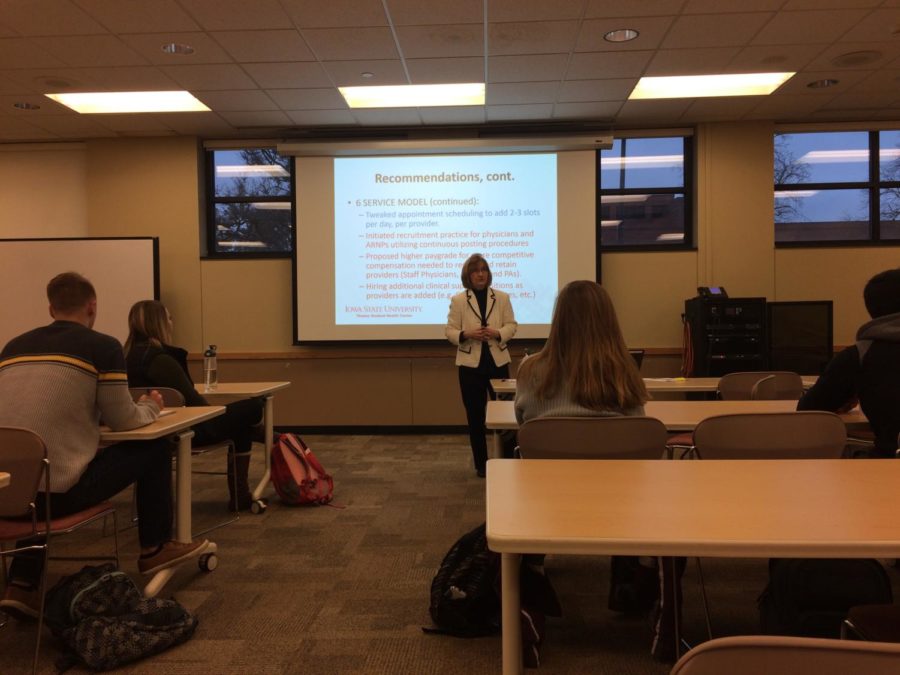SHAC brings ideas to help the Thielen Student Health Center since the Keeling Report
November 17, 2015
The Student Health Advisory Committee hosted an outreach program Tuesday in the Union Drive Community to explain the steps being taken at the Thielen Student Health Center.
“We want to do things that are sustainable. We want to do things that are critical,” said Martino Harmon, associate vice president for Student Affairs.
Harmon started by acknowledging to the 16 people in attendance the negative stigma that follows student health centers, but continued by explaining the purpose of the outreach is to inform the public and change the future of the health center.
He pointed out the increase in enrollment challenged numerous of areas in the university, including the Student Health Center. He addressed the two-to-three-day visit the Keeling Associates used to analyze and produce the 59-page report on the center’s services.
“We accepted the document — may not [have] agreed with every point — but we accepted it, and we used it as a playbook to move forward,” Harmon said.
He introduced Mary Hensley, the Student Health Center’s interim director, who began with the philosophy based off of her son’s cross-country concept that she uses when considering the center: Plan your race, race your plan.
Hensley was brought to the Health Center in mid July. Bridget Konz, quality improvement officer, started around the same time. However, a search for a quality improvement permanent director, or a leader who focuses on the improvement of the health center for the long term, was launched in early July.
For management, Sara Parris joined the Health Center in late September as the assistant director for administrative services. Dr. Cosette Scallon joined as associate director for clinical services. Scallon’s position allows her to be a physician with management authority while the center’s administration looks for a permanent director.
Addressing quality management, Konz has been leading preparations for accreditation from the Accreditation Association for Ambulatory Health Care. The association would review and update policies and procedures that are currently in progress. The Thielen Student Health Center has eliminated use of paper charts, as well. Training for the staff, including additional training involving Health Insurance Portability and Accountability Act, commonly known as HIPAA, which is a medical confidentiality act set in place in 1996, started in September.
There has also been recognition of services that the Student Health Center provides including Clinical Laboratory Improvement Act inspection, which was completed Aug. 27 with “flying colors,” Hensley said.
The Centers for Disease Control and Prevention and the Iowa Department of Public Health recognized the health center for its participation in the U.S. Outpatient Influenza-like Illness Surveillance Network.
“The center is not required to do that. It is an extra service we have been able to participate in,” Hensley said.
The Patient Satisfaction Survey conducted by the American Health Association revealed the Student Health Center received an average score of 4.2 on a five-point scale, with the national average being 4.3. However, a new system for accepting feedback and thoughts about improvement has been implemented in order to enhance the Student Health Center.
The quality of care was shown by the certified medical assistants, who are becoming the first point of contact for students. The center is hiring four of these assistants to replace clerks at the clinic’s reception desk.
The Student Health Center is in the process of moving mental health services to the second floor of the building.
“In mental health appointments you don’t need an exam, it’s more of an interview, so these rooms can be used very quickly,” Hensley said.
Hensley and Harmon were quick to correct the misconception that the mental health services offered by the health center are not the same thing as those offered by Student Counseling Services.
“Counseling Services is a separate operation than the Student Health Center,” Harmon said. “They do connect, work together and collaborate.”
As it adds providers, the center’s goal is that it reaches a ratio so that there are more nurse practitioners than physicians. The center aims for a 2-to-1 ratio as suggested by the Keeling report.
The Prevention Services department is trying to expand with talk of a new ISU wellness initiative to provide more inclusive health incentives to make students all-around healthy. Mary Raman, nurse practitioner, is writing a proposal for the new, long-term, concept strategy of a women’s health service.
As for the physical aspect of the health center, vinyl flooring for exam rooms will be included in new constructions, as well as chairs for the exam rooms and waiting room that can be easily sanitized.
A $10 health fee increase for each student per semester has been approved by different levels of administration, including President Steven Leath, and is expected go into effect fall 2016. The health center is analyzing the possibility of inserting a third-party billing for office visits before addressing policy issues that may come next.
The Student Health Center is focused on building a budget. Managers were asked to create a budget based on what they needed and then reported the end amount. The budget was implemented for the 2015-16 school year.
However, the Student Health Center is ready to address ongoing challenges in the long term, including the continuous enrollment increase, modification to university recruitment methods in order to recruit more physicians, change in provider retirements and the need for staff as the need for services grows.
“How do we meet the needs and still be thoughtful,” said Kipp Van Dyke, assistant dean of students. “I think it’s phenomenal looking at those dates [of plans being implemented]. I think they’ve spark-plugged and got it going.”







